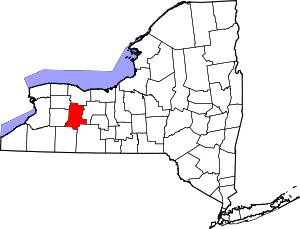Livonia (village), New York
| Livonia, New York | |
|---|---|
| Village | |
 Livonia, New York Location within the state of New York | |
| Coordinates: 42°49′12″N 77°40′5″W / 42.82000°N 77.66806°WCoordinates: 42°49′12″N 77°40′5″W / 42.82000°N 77.66806°W | |
| Country | United States |
| State | New York |
| County | Livingston |
| Area | |
| • Total | 1.0 sq mi (2.6 km2) |
| • Land | 1.0 sq mi (2.6 km2) |
| • Water | 0.0 sq mi (0.0 km2) |
| Elevation | 1,033 ft (315 m) |
| Population (2010) | |
| • Total | 1,409 |
| Time zone | Eastern (EST) (UTC-5) |
| • Summer (DST) | EDT (UTC-4) |
| ZIP code | 14487 |
| Area code(s) | 585 |
| FIPS code | 36-42950 |
| GNIS feature ID | 0955754 |
Livonia is a village located in the Town of Livonia, Livingston County, New York, at the intersection of U.S. Route 20A and Route 15. The population was 1,409 at the 2010 census.
Geography
Livonia is located at 42°49′12″N 77°40′5″W / 42.82000°N 77.66806°W (42.820009, -77.668176).[1]
According to the United States Census Bureau, the village has a total area of 1.0 square miles (2.6 km²). None of the area is covered with water.
History
The region was home to Native Americans belonging to the Seneca people of the Iroquois confederacy. The name for the lake was "Ga-ne-a-sos," which became the modern "Conesus."
Solomon Woodruff became the first white settler in 1789. He built a rough cabin, cleared a field, and planted his first crop of potatoes before returning to Connecticut for his family. He returned by oxcart with his wife to find that the Seneca had burned the cabin to the ground. (His son died on the journey and was buried on a hilltop in Bristol NY). Solomon rebuilt the cabin and his descendants still reside in the area. Solomon is buried in the Union cemetery.
The area in which the town now nestles, between Conesus and Hemlock lakes, was settled by people of European descent in the middle of the 19th century. The creation of a railway line in the 1850s to Lakeville, now part of Livonia, increased business opportunities and travel through the region.
The Livonia Baptist Church was added to the National Register of Historic Places in 1977.[2]
Demographics
| Historical population | |||
|---|---|---|---|
| Census | Pop. | %± | |
| 1880 | 688 | — | |
| 1890 | 738 | 7.3% | |
| 1900 | 865 | 17.2% | |
| 1910 | 823 | −4.9% | |
| 1920 | 743 | −9.7% | |
| 1930 | 774 | 4.2% | |
| 1940 | 751 | −3.0% | |
| 1950 | 837 | 11.5% | |
| 1960 | 946 | 13.0% | |
| 1970 | 1,278 | 35.1% | |
| 1980 | 1,238 | −3.1% | |
| 1990 | 1,434 | 15.8% | |
| 2000 | 1,373 | −4.3% | |
| 2010 | 1,409 | 2.6% | |
| Est. 2015 | 1,351 | [3] | −4.1% |
As of the census[5] of 2000, there were 1,373 people, 534 households, and 370 families residing in the village. The population density was 1,343.5 people per square mile (519.7/km²). There were 560 housing units at an average density of 548.0 per square mile (212.0/km²). The racial makeup of the village was 97.31% White, 0.87% Black or African American, 0.36% Native American, 0.22% Asian, 0.07% from other races, and 1.17% from two or more races. Hispanic or Latino of any race were 1.02% of the population.
There were 534 households out of which 40.3% had children under the age of 18 living with them, 51.9% were married couples living together, 13.7% had a female householder with no husband present, and 30.7% were non-families. 25.5% of all households were made up of individuals and 11.0% had someone living alone who was 65 years of age or older. The average household size was 2.57 and the average family size was 3.09.
In the village the population was spread out with 30.6% under the age of 18, 6.6% from 18 to 24, 30.0% from 25 to 44, 22.3% from 45 to 64, and 10.5% who were 65 years of age or older. The median age was 35 years. For every 100 females there were 94.5 males. For every 100 females age 18 and over, there were 89.1 males.
The median income for a household in the village was $49,688, and the median income for a family was $55,096. Males had a median income of $41,310 versus $25,069 for females. The per capita income for the village was $21,115. About 3.5% of families and 6.0% of the population were below the poverty line, including 9.9% of those under age 18 and 6.5% of those age 65 or over.
References
- ↑ "US Gazetteer files: 2010, 2000, and 1990". United States Census Bureau. 2011-02-12. Retrieved 2011-04-23.
- ↑ National Park Service (2009-03-13). "National Register Information System". National Register of Historic Places. National Park Service.
- ↑ "Annual Estimates of the Resident Population for Incorporated Places: April 1, 2010 to July 1, 2015". Retrieved July 2, 2016.
- ↑ "Census of Population and Housing". Census.gov. Retrieved June 4, 2015.
- ↑ "American FactFinder". United States Census Bureau. Retrieved 2008-01-31.
